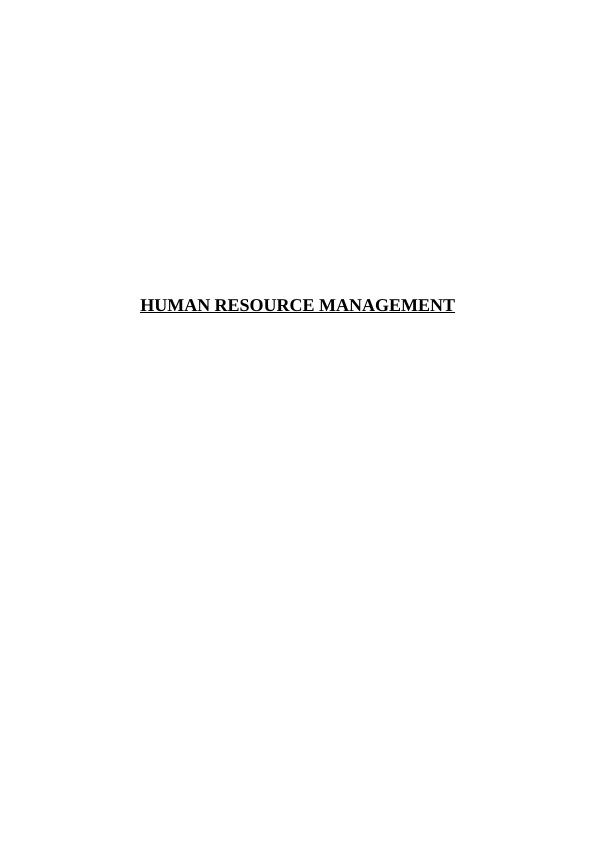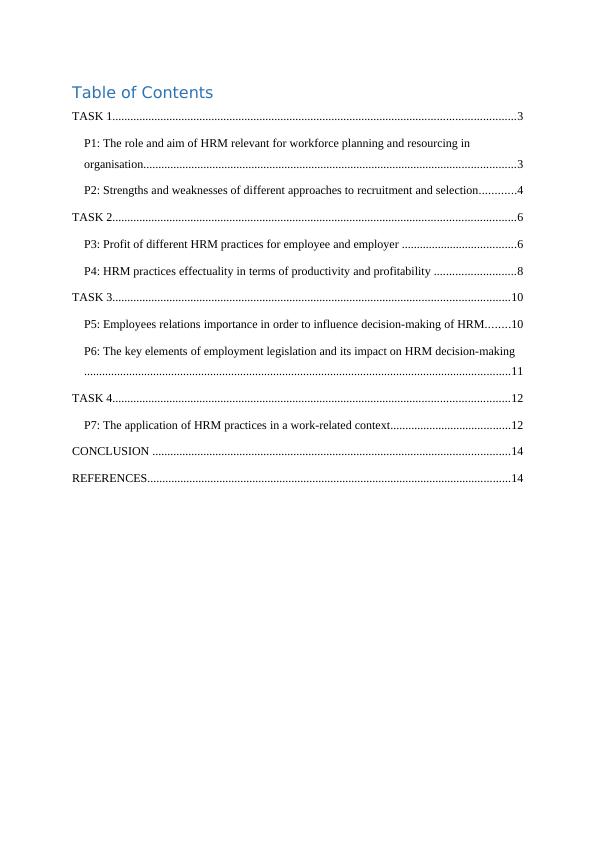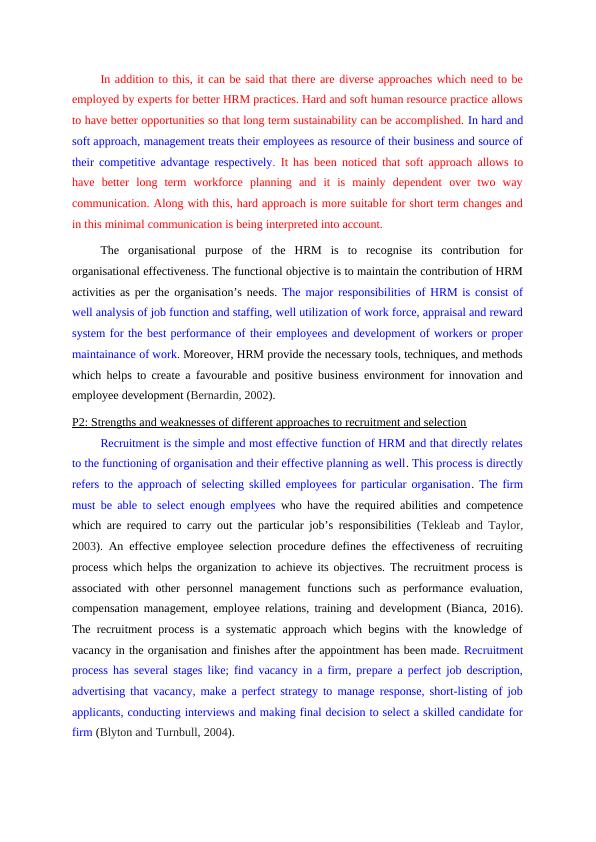The role and aim of Human Resource Management
Added on 2020-02-17
16 Pages5425 Words2730 Views
HUMAN RESOURCE MANAGEMENT

Table of ContentsTASK 1......................................................................................................................................3P1: The role and aim of HRM relevant for workforce planning and resourcing in organisation............................................................................................................................3P2: Strengths and weaknesses of different approaches to recruitment and selection............4TASK 2......................................................................................................................................6P3: Profit of different HRM practices for employee and employer ......................................6P4: HRM practices effectuality in terms of productivity and profitability ...........................8TASK 3....................................................................................................................................10P5: Employees relations importance in order to influence decision-making of HRM........10P6: The key elements of employment legislation and its impact on HRM decision-making..............................................................................................................................................11TASK 4....................................................................................................................................12P7: The application of HRM practices in a work-related context........................................12CONCLUSION .......................................................................................................................14REFERENCES.........................................................................................................................14

INTRODUCTIONAll field has obtained advancement for the reason to meet the requirements of time.Through its systematic methodology, the management has now become an art. An innovativemanagement type which is prevailing and spreading in the business firms is human resourcemanagement. A company cannot build a good team of professionals at the workplace withouthaving an effective human resource management. Here, the report is briefing about the keyfunctions and role played by the HR manager in the recruitment, selection and propermanagement of manpower in the company. Several HRM practices and their implications atthe workplace is also defined to measure its benefits for the Canary Wharf firm. The paper isalso illustrating elements of employees’ legislation together with its impact on HRM decisionmaking and practices. TASK 1P1: The role and aim of HRM relevant for workforce planning and resourcing in organisationHRM basically refers to managing people and their specific task within an organization.Many authors and scholars had tried to define human resource management in differentwords and ways, however,it basically describes that how to manage employees in the firm.As per the view of Decenzo and Robbins (1988), HRM deals with the people conception inbusiness management. Another definition by Mathis & Jackson (2003), human resourcemanagement is a formal system which is designed to ensure optimum utilization of humantalent in order to achieve organisational objectives. Thus, HRM can be defined as asystematic process of procuring, developing and maintaining available limited skilledworkforce so that the human resource is effectively and efficiently utilised for achievingorganisational goals (Auer and Cazes, 2003).It's the employee who carry out several work activities in an organization.The majorrole of HR manager is that managing people in a proper way so that they can work veryefficiently to perform such type of activities. Therefore, HRM mainly deals with severalactivities that directly relates to the employees such as hiring and recruiting, performancemanagement, compensation, training and development, safety, wellness, goodness, employeemotivation, dispute resolution and communication (Wilthagen and Tros, 2004). In this way,HR professionals work as a consultant for managers in the organisation advising them how toplan an action to managing people as enterprise resources and how to utilize them forachieving organisational goals (Benjamin, 2017).

In addition to this, it can be said that there are diverse approaches which need to beemployed by experts for better HRM practices. Hard and soft human resource practice allowsto have better opportunities so that long term sustainability can be accomplished. In hard andsoft approach, management treats their employees as resource of their business and source oftheir competitive advantage respectively. It has been noticed that soft approach allows tohave better long term workforce planning and it is mainly dependent over two waycommunication. Along with this, hard approach is more suitable for short term changes andin this minimal communication is being interpreted into account. The organisational purpose of the HRM is to recognise its contribution fororganisational effectiveness. The functional objective is to maintain the contribution of HRMactivities as per the organisation’s needs. The major responsibilities of HRM is consist ofwell analysis of job function and staffing, well utilization of work force, appraisal and rewardsystem for the best performance of their employees and development of workers or propermaintainance of work. Moreover, HRM provide the necessary tools, techniques, and methodswhich helps to create a favourable and positive business environment for innovation andemployee development (Bernardin, 2002).P2: Strengths and weaknesses of different approaches to recruitment and selectionRecruitment is the simple and most effective function of HRM and that directly relatesto the functioning of organisation and their effective planning as well. This process is directlyrefers to the approach of selecting skilled employees for particular organisation. The firmmust be able to select enough emplyees who have the required abilities and competencewhich are required to carry out the particular job’s responsibilities (Tekleab and Taylor,2003). An effective employee selection procedure defines the effectiveness of recruitingprocess which helps the organization to achieve its objectives. The recruitment process isassociated with other personnel management functions such as performance evaluation,compensation management, employee relations, training and development (Bianca, 2016).The recruitment process is a systematic approach which begins with the knowledge ofvacancy in the organisation and finishes after the appointment has been made. Recruitmentprocess has several stages like; find vacancy in a firm, prepare a perfect job description,advertising that vacancy, make a perfect strategy to manage response, short-listing of jobapplicants, conducting interviews and making final decision to select a skilled candidate forfirm (Blyton and Turnbull, 2004).

End of preview
Want to access all the pages? Upload your documents or become a member.
Related Documents
Functions of HRM for workforce planning and resourcinglg...
|19
|4463
|318
P1 Purpose and the Functions of HRMlg...
|13
|3879
|90
Human Resource Management - Marks and Spencer Assignmentlg...
|14
|4563
|68
Human Resource Management in Marks and Spencer : Reportlg...
|14
|3992
|48
P1 Explain the Purpose And Functions of HRMlg...
|15
|4901
|343
Human Resource Management - Hewlett Packard (HP) Companylg...
|14
|3874
|295
